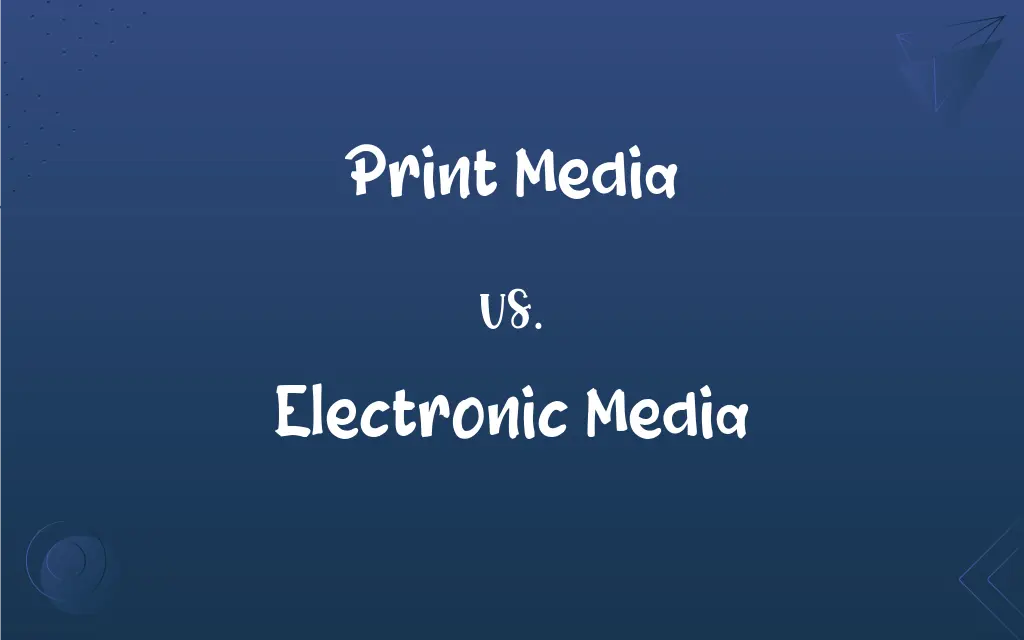Print Media vs. Electronic Media: What's the Difference?
Edited by Janet White || By Harlon Moss || Updated on October 5, 2023
Print media encompasses materials that are available in printed form, while electronic media includes content available through electronic devices.

Key Differences
Print media traditionally consists of materials that are physically printed and distributed, such as newspapers, magazines, and brochures. Electronic media, in contrast, spans content distributed via electronic devices, like television broadcasts, radio, and internet platforms.
The accessibility of print media generally demands physical transfer and is tangible, being accessible without the need for electronic devices. Electronic media requires technological interfaces such as computers, TVs, or radios, inherently demanding energy sources and electronic access.
Print media offers a static interaction with content, preserving information in a fixed format that doesn’t change. Electronic media provides dynamic and interactive platforms where content can be updated in real-time, offering immediacy and current information.
While print media production involves a tangible manufacturing process including printing and possibly physical distribution, electronic media can be disseminated virtually, cutting down on physical production costs and time.
The archival and retrieval of print media often involve physical storage and can be susceptible to physical wear and tear. On the other hand, electronic media provides scalable, digital archiving options, albeit with considerations regarding format obsolescence and digital decay.
ADVERTISEMENT
Comparison Chart
Medium
Physical paper/material
Electronic devices
Accessibility
Direct physical access
Requires electronic access
Interactivity
Generally static
Interactive & dynamic
Distribution
Physical transfer
Virtual dissemination
Archiving
Physical storage
Digital storage
ADVERTISEMENT
Print Media and Electronic Media Definitions
Print Media
Print media production involves physical manufacturing and potentially, distribution processes.
The costs associated with print media include not only content creation but also printing and delivery.
Electronic Media
Electronic media requires technological interfaces and sources of power for content access.
Despite the power outage, he could access electronic media through his charged laptop, staying informed via online news portals.
Print Media
Print media can serve as an accessible format for readership, requiring no electronic devices to access the content.
She appreciated the print media for its straightforward accessibility, relishing her morning paper with coffee.
Electronic Media
Electronic media provides dynamic platforms, enabling interactivity and real-time content updates.
Through electronic media, she engaged in lively debates and discussions on online forums and platforms.
Print Media
Print media pertains to publications such as newspapers, magazines, and books that are printed for distribution.
The magazine stands as a staple of print media, providing monthly insights and articles.
Electronic Media
Electronic media allows for digital archiving, storage, and retrieval of content.
The journalist retrieved decades-old broadcasts from the electronic media archives to craft her documentary.
Print Media
Print media often serves as a tangible source of information, with physical materials that can be held and collected.
Many historians value print media, like newspapers, for preserving snapshots of historical moments.
Electronic Media
Electronic media distribution is typically virtual, enabling instantaneous global reach.
The podcast, a segment of electronic media, reached listeners worldwide immediately upon release.
Print Media
Print media may provide an archival quality, with materials often preserved in libraries and personal collections.
Researchers utilize archives of print media to explore the sociocultural discussions of the past.
Electronic Media
Electronic media encompasses content distributed via electronic devices, such as TV, radio, and the internet.
News channels, as a form of electronic media, offer real-time updates on global events.
FAQs
What is included in electronic media?
Electronic media involves content on TV, radio, internet platforms, and other digital interfaces.
Is print media subject to wear and tear?
Yes, since print media is physical, it can degrade over time, suffering from factors like yellowing, tears, and environmental damage.
What do you need to access electronic media?
Access to electronic media requires an electronic device, such as a TV, computer, or radio, and often an internet connection.
How is print media accessed?
Print media is accessed physically, requiring no electronic devices, making it tangible and portable.
Can print media provide interactive content?
Print media is generally static, offering limited interactivity, usually through additional QR codes or similar technologies.
How does electronic media reach its audience?
Electronic media can be disseminated virtually and instantaneously to global audiences via internet or broadcast networks.
What capabilities does advertising have in electronic media?
Advertising in electronic media can be dynamic, targeted, and interactive, utilizing audio-visual content and user engagement.
How are electronic media contents archived?
Electronic media is archived digitally, enabling scalable storage but requiring format management and data protection.
What encompasses print media?
Print media includes newspapers, magazines, brochures, and any other printed materials.
How is print media traditionally distributed?
Print media is typically distributed physically through retail outlets, subscription services, or direct mail.
How interactive is electronic media?
Electronic media provides highly interactive platforms, allowing users to engage, respond, and manipulate content in real-time.
How efficient is electronic media in delivering real-time updates?
Electronic media excels at delivering real-time updates, offering instant access to breaking news and developments.
How widespread can electronic media distribute content?
Electronic media can distribute content instantly across global networks, reaching diverse and widespread audiences.
Can print media offer multimedia content?
Print media is limited to text and images, lacking the multimedia capabilities that electronic platforms offer.
How permanent is content in electronic media?
Content in electronic media can be dynamically updated, altered, or deleted, making it less permanent than print media.
How is advertising approached in print media?
Advertising in print media involves static ads that are physically printed, offering visual and textual content to readers.
Can print media content be accessed globally?
Print media’s global accessibility is hindered by physical distribution limits and may require digital interfaces for international reach.
What are the storage demands of print media archives?
Print media archives require physical storage, which can be space-intensive and require preservation against degradation.
What multimedia capabilities does electronic media have?
Electronic media can integrate text, images, video, and audio, providing a multimedia user experience.
How does print media handle breaking news?
Print media may have limitations in delivering breaking news promptly due to physical printing and distribution times.
About Author
Written by
Harlon MossHarlon is a seasoned quality moderator and accomplished content writer for Difference Wiki. An alumnus of the prestigious University of California, he earned his degree in Computer Science. Leveraging his academic background, Harlon brings a meticulous and informed perspective to his work, ensuring content accuracy and excellence.
Edited by
Janet WhiteJanet White has been an esteemed writer and blogger for Difference Wiki. Holding a Master's degree in Science and Medical Journalism from the prestigious Boston University, she has consistently demonstrated her expertise and passion for her field. When she's not immersed in her work, Janet relishes her time exercising, delving into a good book, and cherishing moments with friends and family.































































